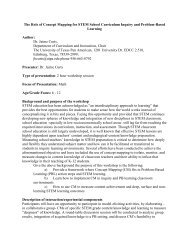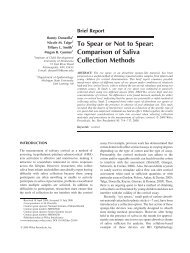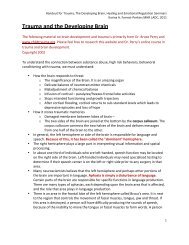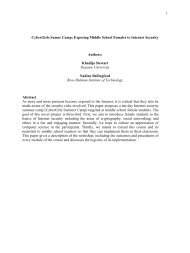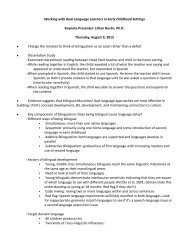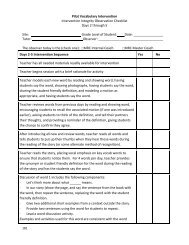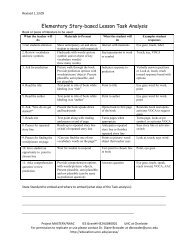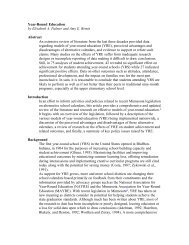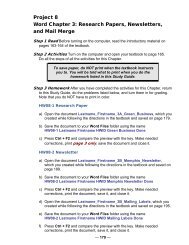Introduction to Positive Ways of Intervening with Challenging Behavior
Introduction to Positive Ways of Intervening with Challenging Behavior
Introduction to Positive Ways of Intervening with Challenging Behavior
You also want an ePaper? Increase the reach of your titles
YUMPU automatically turns print PDFs into web optimized ePapers that Google loves.
• Jigsaw tasks so that each team member has needed information. The student must then work <strong>with</strong> group<br />
members in order <strong>to</strong> complete the task.<br />
4. Taking charge: When a student “takes charge,” you will observe him or her refusing <strong>to</strong> let other group<br />
members do work, ordering other team members around, doing all the work, bullying other members, or<br />
making team decisions <strong>with</strong>out the input <strong>of</strong> other members. In such cases, you can:<br />
• Jigsaw materials and resources so that the student cannot complete the task <strong>with</strong>out input from other<br />
members.<br />
• Assign group roles so that other group members have more powerful roles such as reader, secretary,<br />
summarizer, etc.<br />
• Reward the group on the basis <strong>of</strong> the lowest group score(s). This will pressure the student <strong>to</strong> help and<br />
cooperate <strong>with</strong> others so that they learn the material.<br />
How should I assign grades for teamwork?<br />
Johnson and Johnson (1991) give the following suggestions for assigning grades <strong>to</strong> cooperative learning tasks:<br />
1. Individual score plus bonus points based on all members reaching criterion: After studying or working<br />
<strong>to</strong>gether, each student completes his or her own work. He or she then receives a grade plus bonus points if all<br />
group members have achieved a preset criterion <strong>of</strong> success.<br />
2. Individual score plus bonus points based on lowest score: After studying or working <strong>to</strong>gether, each student<br />
completes his or her own work. Members then receive a grade plus bonus points on the basis <strong>of</strong> the lowest<br />
individual score in their team.<br />
3. Individual score plus group average: After studying or working <strong>to</strong>gether, each student completes his or her<br />
own work. He or she is awarded a grade consisting <strong>of</strong> his or her individual score plus the score which is the<br />
average score <strong>of</strong> the group.<br />
4. Individual score plus bonus based on improvement scores: After studying or working <strong>to</strong>gether, each<br />
student completes his or her own work. Each student is then awarded a grade which consists <strong>of</strong> his or her<br />
individual score plus bonus points if the group score average has improved from the last task. Every two or<br />
three tasks, the base score (on which bonus points are based) is updated.<br />
5. Totaling members’ individual scores: The individual scores <strong>of</strong> members are added up and all members<br />
receive the <strong>to</strong>tal <strong>of</strong> all the scores.<br />
6. Averaging <strong>of</strong> members’ individual scores: The individual scores <strong>of</strong> members are added up and an average<br />
is taken. All team members receive this average.<br />
7. Group score on a single product: Team members work <strong>to</strong>gether <strong>to</strong> produce one product and all students<br />
receive the grade given the product.<br />
8. Randomly selecting one member’s paper <strong>to</strong> score: After working or studying <strong>to</strong>gether, each group member<br />
completes the task individually. One product is then randomly chosen and all team members receive the grade<br />
awarded this product.<br />
9. All members receive the lowest score: After working or studying <strong>to</strong>gether, each group member completes<br />
his or her own work. All members then receive the lowest score <strong>of</strong> the team. This method dramatically<br />
improves the performance <strong>of</strong> low achievers since everyone in the group is motivated <strong>to</strong> help him or her<br />
achieve.




